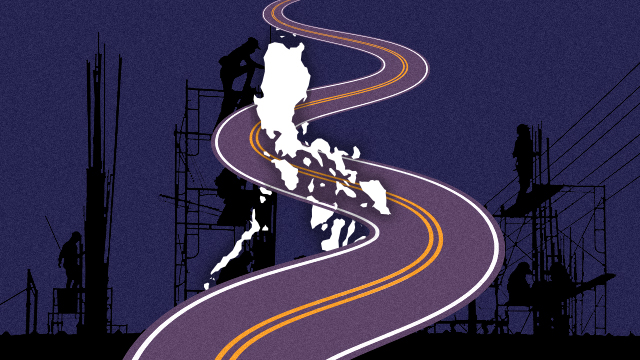

They promised us a “golden age of infrastructure.” But all we got so far is a pipe dream.
Build, Build, Build is being touted as the Duterte administration’s flagship economic project. With an original expected cost of P8.4 trillion spread over 6 years, Build, Build, Build is meant to usher in a “golden age of infrastructure,” bringing in new railways, roads, bridges, airports, etc.
But more than two years since its launch, only two of the 75 projects have been completed as of April 2019.
Sure, 9 other projects are “ongoing,” and many more are in the pipeline. But President Rodrigo Duterte is stepping down from office in less than 3 years, and relative to the targets set by the economic managers for themselves, this is hardly the golden age they promised to deliver.
What’s the status of the Build, Build, Build projects? Why have they proceeded so slowly? How are we going to pay for them?
1) Only two projects have been completed as of April 2019
The latest comprehensive status report on Build, Build, Build is available from the website of the National Economic and Development Authority (NEDA).
As of April, at least 37 – or about half – of the projects have been approved by the NEDA Board. Another 29 are awaiting approval, and 9 need no approval at all.
Only two projects have been completed so far (Table 1). They are relatively minor and obscure, and both cost only a little over P1.2 billion. That’s just 1% of 1% of the original P8.4 trillion expected cost of Build, Build, Build.
Table 1
The 9 ongoing projects represent only 12% of all identified projects. None of the big-ticket projects – like the Metro Manila Subway, 3 new PNR lines, and the Subic-Clark Railway – have yet broken ground. They are in various stages of detailed engineering design, budgeting/financing, or procurement.
Spending is so much weaker than expected. The economic managers had promised to spend P847 billion in 2017 and P1.2 trillion in 2018. But actual infrastructure disbursements fell short of these amounts by 18% and 26%, respectively (Figure 1).
Although infrastructure spending last year amounted to 5.1% of the nation’s income “for the first time in our history,” the economic managers had promised to spend a higher percentage (5.4%) back in 2017.
Figure 1
If you listen to the pre-SONA forum presented by Public Works and Highways Secretary Mark Villar, you might get the impression that Build, Build, Build has met many of its goals. He said proudly, “We are already halfway in revolutionizing our infrastructure.”
But this sense of accomplishment is illusory.
Many of the projects that Villar mentioned – like the new terminal at the Mactan Cebu International Airport and the Parañaque Integrated Terminal Exchange – are in fact carryovers from the previous administration. Nonetheless, they have all been conveniently folded into Duterte’s Build, Build, Build.
2) Three-fourths of the projects will be funded by foreign loans and grants
The financing of Build, Build, Build has also changed considerably since 2017.
Back then the economic managers said only 15% of total costs will be financed by foreign loans and grants (otherwise known as official development assistance or ODA). In contrast, they added, 18% will be financed through public-private partnerships or PPPs.
But latest data show that 75% of the projects (or 91% of total costs) are now financed by ODA (Table 1). Only 11% of the projects (or 4.5% of total costs) are financed by PPPs.
The economic managers shunned PPPs precisely because they thought ODA would be faster.
But even Socioeconomic Planning Secretary Ernesto Pernia now admits that this is not necessarily true: “We thought that things would move fast, but they are not moving as fast as we expected.”
Moreover, about 42% of the new loans will be financed by China, wholly or partially. The two grant-funded projects (the Binondo-Intramuros Bridge and the Estrella-Pantaleon Bridge) are also Chinese-funded.
Note that China didn’t offer us infrastructure loans until Duterte came along. Conceivably, China’s abiding interest in Build, Build, Build aligns with their own infrastructure push called the Belt and Road Initiative.
But Chinese loans tend to include onerous provisions, as pointed out by Supreme Court Senior Associate Justice Antonio Carpio.
Halfway through Duterte’s term, China also has yet to commit to finance some of Duterte’s favorite projects, like the Mindanao Railway Project. Why the hesitation?
3) Congress derailed Build, Build, Build
Meanwhile, the late passage of the 2019 budget has derailed other Build, Build, Build projects.
Lawmakers hijacked the budget cycle last year, and Duterte’s Cabinet had to contend with a reenacted budget for the first third of 2019.
Consequently, economic growth foundered to a mere 5.6% in the first quarter of this year, the lowest in 4 years. Public construction shrank for the first time since 2015.
This budget delay is utterly baffling. Doesn’t Duterte already control Congress via the supermajority?
At any rate, budget delays of this sort are unacceptable at a time when the government is gunning for an infrastructure golden age.
4) Budget deficit is already widening
Finally, although Build, Build, Build has yet to proceed at full throttle, the nation’s coffers are already straining.
Former budget secretary Benjamin Diokno (now the Bangko Sentral governor) assured us before that the government’s budget deficit (or revenue shortfall) will not exceed 3% of the nation’s income “all throughout” Duterte’s term.
But in recent years, the government’s budget deficit has been rising steadily (Figure 2). In July 2019, the economic team has also raised the deficit ceiling to 3.2%, presumably realizing that Diokno’s original 3% target is now untenable.
Figure 2
With many more infrastructure projects in the pipeline – and new big-ticket social programs like universal healthcare, free tuition, and higher government salaries – expect a ballooning deficit in Duterte’s last 3 years.
Finance Secretary Carlos Dominguez III recently assured us that the 2017 TRAIN law “provided a solid footing for our infrastructure spending program.”
But revenues from TRAIN are quite small. In 2018 they totaled only P68.4 billion, just 8% above target and a puny 8% of total infrastructure disbursements in that year.
A wider budget deficit is no cause for concern per se. But we don’t want it to soar because each episode of deficit adds to the country’s debt stocks.
Not as easy at it looks
We need to ramp up infrastructure spending to sustain economic growth in the coming decades.
But through a combination of unrealistic targets and unacceptable budget delays, Duterte’s Build, Build, Build program has clearly not yet delivered.
Is this why Duterte mentioned Build, Build, Build in his latest State of the Nation Address (SONA) only in passing?
Transportation Secretary Arthur Tugade once joked that when it comes to infrastructure previous administrations were only capable “talk, talk, talk.”
But as I’m sure Duterte’s Cabinet is now realizing, ushering in a golden age of infrastructure is not as easy as it looks.
Luckily for them, plenty more projects from the previous administrations will need ribbon-cutting ceremonies. – Rappler.com
The author is a PhD candidate at the UP School of Economics. His views are independent of the views of his affiliations. Follow JC on Twitter (@jcpunongbayan) and Usapang Econ (usapangecon.com).